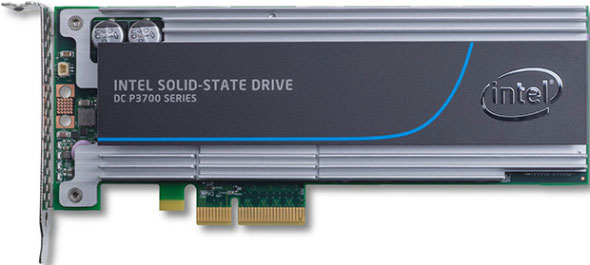Our Aim
To provide you with an overview on New And existing technologies, hopefully helping you understand the changes in the technology. Together with the overviews we hope to bring topical issues to light from a series of independent reviewers saving you the time And hassle of fact finding over the web.
We will over time provide you with quality content which you can browse and subscribe to at your leisure.
TekSpek 's

INTEL Enterprise SSDs
Date issued:
One of the greatest advances for PCs in recent years has been the introduction of solid-state drives (SSD). These storage drives hold information on flash memory that is managed by a processing chip called a controller. Advantages of SSDs over traditional spinning disks are numerous, from silent operation, lower power to significantly faster performance.
And it's performance that happens to be the main draw. Modern SSDs can push data at over 500MB/s, which over the twice the speed of the best mechanical disks. Perhaps more tellingly, the nature of flash memory means it is substantially quicker when transferring small files, to the tune of being 100x faster.
SSDs are generally available in 128GB to 2TB capacities, and larger models tend to be speedier because they can take full advantage of the controller's ability through increased parallelism. Yet SSDs are not all the same; there are those designed for the home/consumer/client environment and others that specifically target the enterprise/workstation markets.
Consistent, predictable performance for multiple users.
Enterprise SSDs have the same building blocks as client models, so they house a processing chip and flash memory on to a PCB that is presented in various form factors - 2.5in, M.2, add-in card, etc. It's the quality of the processor/flash combination that is different.
It is far more important to have consistent, long-term reliability from enterprise storage because, being deployed in areas such as servers and complex storage arrays, predictable performance is key. When thousands of users each access commercial websites and load up information on their browsers it is vital that everyone have the same good experience - enterprise SSDs enable that to happen.
Such a scenario has implications for enterprise SSDs, because they need to serve several users at once and provide performance that does not degrade over time. True enterprise drives are able to achieve this as they use higher-quality flash chips that have a longer lifespan, often quoted in terms of the number of program-erase cycles that can be achieved before the memory cells become unusable. They also usually contain a number of capacitors that activate if there's a temporary loss of power, thereby safeguarding data resident on the drive.
Reliability and endurance
Going hand in hand with consistent performance are attributes such as reliability and endurance. Enterprise drives are tested to perform in far more strenuous environments and timescales than consumer drives. For example, a company may release a consumer SSD that is qualified to work eight hours a day at an ambient temperature of 40°C, which is likely inside a regular computer case for home users. Enterprise drives, by their very nature, need to be on for longer periods, often 24 hours a day and seven days a week, so designers use higher-quality controllers and flash memory that is able to meet such stringent requirements. Validation of better-performing components is key in this regard.
Flash memory works by passing an electric current over the memory cells during the program and erase sequence. Such energy, over time, weakens the flash cell structure enough for it to become permanently damaged and unusable. All SSDs are prone to this problem over time, and while techniques such as wear-levelling paper over the cracks, all SSDs will fail eventually.

The Intel DC P3700 is a very fast drive, available in capacties up to 2TB.
Ameliorating this problem to a degree, enterprise drives are significantly better than their client counterparts in terms of longevity due to the improvements in flash design; they are said to have vastly improved endurance. The best SSDs can be written to and erased multiple times a day for numerous years before this cell-destroying problem cannot be corrected by clever software and wear-levelling algorithms. Client drives, on the other hand, have a much lower endurance rating, perhaps only one-tenth as much, but they're less prone to 24/7 usage.
Built for speed
Consistency and reliability are clear virtues for enterprise drives, but they're also very fast, particularly if using the latest technologies such as NVMe. Enterprise drives use flash controllers that can process and pass more information per second than client drives, and such controllers are said to have more channels for increased data-transfer parallelism. Such is the speed for both small and large file transfers that the usual SATA6Gbps interface, found on almost all consumer drives, is not nearly fast enough.
Enter NVMe, or non-volatile host controller interface, which is designed to exploit the naturally low latency and greater inherent data-transfer parallelism for enterprise drives that connect to the system via the high-bandwidth PCIe bus.
A fast controller, top-quality flash memory and an NVMe connection to the motherboard and CPU enables enterprise drives to offer mind-boggling performance. Numbers such as 2,500MB/s sequential reading and 500,000 IOPS are common for a single enterprise drive, dwarfing what is available in the consumer space.
Enterprise SSDs, then, use the same design blueprint as the fast storage in your system but are engineered to provide more speed, reliability, endurance and predictable performance over time. Such innovation means they're considerably more expensive than client SSDs for the same capacity, but would you use anything less in a dataserver, would you?
As always, Scan Computers has a wide selection of enterprise SSDs. You can peruse our selection of Intel Enterprise Series PCIe and SATA SSDs here.